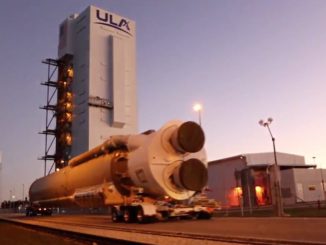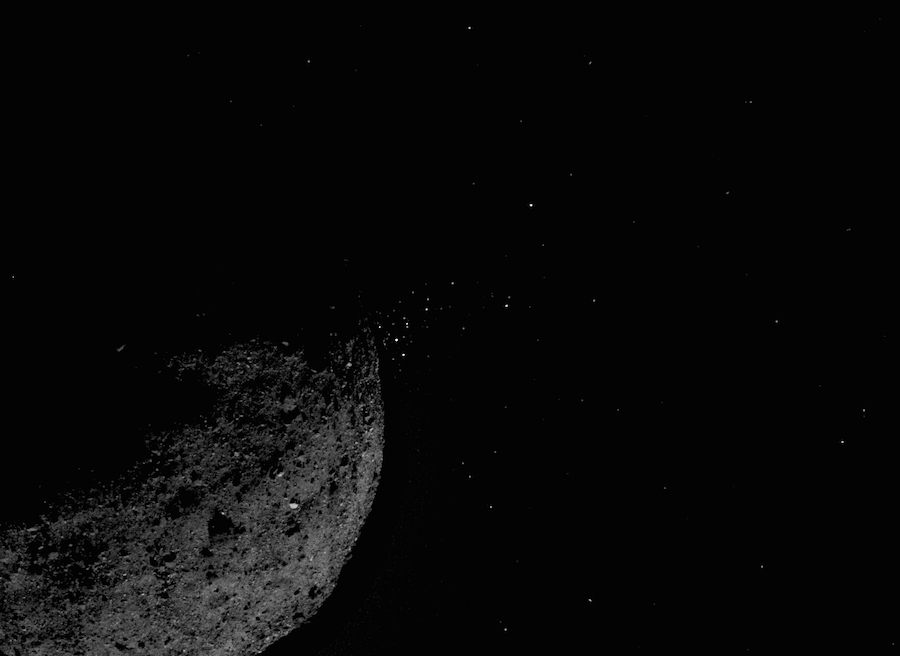
The early months of NASA’s OSIRIS-REx mission’s exploration of asteroid Bennu have revealed big surprises, scientists said Tuesday, including plumes of particles streaming away from the asteroid, sometimes with enough velocity for rocks to break out of Bennu’s tenuous gravitational grip and escape into space.
Mission scientists said Tuesday that OSIRIS-REx has detected the particle plumes on at least 11 occasions, beginning Jan. 6, and experts are not sure what is causing material to eject off of Bennu’s surface.
Dante Lauretta, principal investigator of the $1 billion NASA-funded Origins, Spectral Interpretation, Resource Identification, Security, Regolith Explorer mission at the University of Arizona, said the discovery of rock and pebble particle streams makes Bennu an “active asteroid,” a rare class of small solar system objects with a population of only about a dozen, of which none have been studied up-close.
Some of the debris thrown off Bennu falls back to the asteroid’s surface. OSIRIS-REX’s camera has observed particles traveling at higher speeds entering orbit around the asteroid, while some material moves fast enough to permanently escape Bennu, Lauretta said.
Bennu measures about 1,614 feet (492 meters) across, and is shaped like a spinning top. A ridge around Bennu’s equator is one of the asteroid’s most prominent features, along with numerous boulders, some of which are as big as a multi-story office building. The asteroid is on an oval-shaped path that takes it just inside Earth’s orbit at its closest point to the sun, and there’s a 1-in-2,700 chance Bennu could impact Earth late in the 22nd century.
Since OSIRIS-REx discovered the first plume in early January, scientists sent up commands for the spacecraft to make a more systematic search for the particles streams. Three of the 11 events detected through late February have been substantial, with dozens to more than a hundred particles being ejected, according to Lauretta.
Scientists are finding more plumes as they improve their ability to extract faint signals from reflected sunlight off the particles, Lauretta said Tuesday in a conference call with reporters.
Lauretta said the plume discovery at Bennu was one of the biggest surprises of his scientific career.
The rocks and pebbles seen flying off Bennu range from about a centimeter across to tens of centimeters in size — roughly the dimensions of an M&M up to a laptop computer — with speeds of up to several miles per hour, according to Lauretta.
“Some of those slow-moving particles have been observed over periods of at least a week, and they appear to be trapped in the asteroid’s gravity field and are ending up in orbit around Bennu,” he said. “So it’s creating its own set of natural satellites, and then some of them have been observed to fall back onto the surface.
“Basically, it looks like Bennu has a continuous population of particles raining down on it from discrete ejection events across its surface,” Lauretta said. “This is incredibly exciting. We don’t know the mechanism that is causing this right now. In fact, we’re still learning how to process the data, analyze the information, and make sense of what’s going on at this asteroid.”
One theory under consideration by OSIRIS-REx’s science team is that the plume outbursts could be related to Bennu’s position in its orbit around the sun. The asteroid reached perihelion, its closest point to the sun in its 1.2-year orbit, in early January, a few days after OSIRIS-REx detected the first particle plume.
Comets are under the most intense solar heating as they reach perihelion, warming volatile icy material and triggering eruptions that create a hazy coma around the comet nucleus.
“There is a speculation that this might be related to the close approach, but we haven’t confirmed that yet,” Lauretta said.
OSIRIS-REx has not spotted any eruptions since late February, but the spacecraft has left its orbit around Bennu and is flying at greater distances from the asteroid, which could preclude such observations.
“Bennu is teasing us,” Lauretta said.
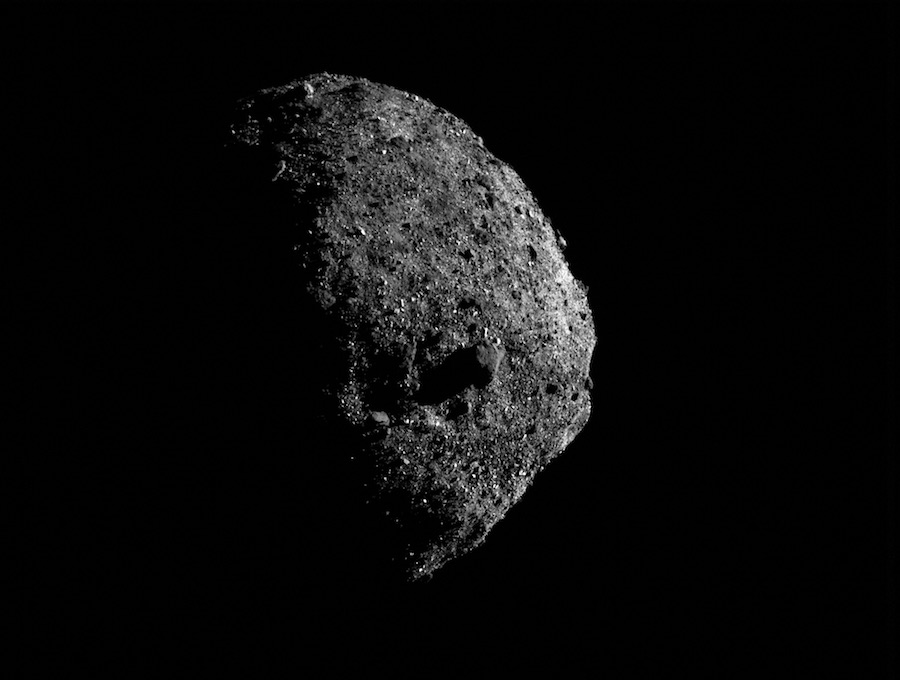
Navigators plotting OSIRIS-REx’s trajectory around Bennu have determined the particle plumes do not pose a threat to the spacecraft, which entered orbit around the asteroid Dec. 31. Bennu became the smallest planetary body ever orbited by a spacecraft, and OSIRIS-REx flew a series of slow-speed loops ranging between 1 mile and 1.3 miles (1.6 kilometers to 2.1 kilometers) from the asteroid.
Bennu’s gravity field is about 100,000 times weaker than Earth’s, so tenuous that flight dynamics specialists must account for other forces, such as solar radiation, acting on the spacecraft as it travels around the asteroid.
Designed to snag a sample from Bennu for return to Earth, OSIRIS-REx launched from Cape Canaveral in September 2016 and arrived in Bennu’s vicinity late last year. Since rendezvousing with Bennu, the spacecraft’s instruments have found clay minerals, hydroxyl and magnetite on the asteroid’s surface. The discoveries suggest the material on Bennu’s surface was once in contact with water.
Scientists say Bennu was formed when an ancient collision blew apart a larger parent body billions of years ago, scattering debris that eventually coalesced into smaller asteroids. The inside of Bennu appears to be porous, and evidence suggests Bennu is a “rubble pile” asteroid formed from clumps of rock gravitationally bonded together.
Measurements from OSIRIS-REx indicate Bennu has a bulk density similar to that of coal.
Bennu spins once every 4.3 hours, and its rotation rate is speeding up, scientists said.
OSIRIS-REx has directly detected the change in Bennu’s spin rate caused by the uneven heating and cooling of the asteroid’s surface as it rotates. Within 1.5 million years, Bennu is projected to rotate at twice its current rate, Lauretta said.
Bennu’s rugged topography forces officials to re-plan sample collection
From a scientific perspective, Lauretta said Bennu turned out to be an “ideal target” for OSIRIS-REx, rich in minerals that will tell researchers about the history of the solar system. Asteroids and comets regularly impacted Earth soon after the planet’s formation more than 4.5 billion years ago, bringing with them water and organic molecules, the building blocks of life.
“As a sample scientist who’s interested in getting this material back into our laboratories here on Earth, this is really exciting because this means that we’re going to have a wide range of materials to study from the dawn of the solar system to understand the processes of planet formation, and even why Earth is a habitable planet, with abundant oceans and the origin of life,” Lauretta said.
But numerous boulders are strewn across Bennu’s surface. OSIRIS-REx’s ground team has counted more than 200 boulders at least 10 meters — 33 feet — in size, many more than scientists predicted based on ground-based radar data on the asteroid.
The rough surface “may pose some challenges for our navigation systems, which rely on LIDAR instruments, which are lasers that reflect off the surface to give us our range to the asteroid, as well as image-based technologies to guide us in to the potential sample site,” Lauretta said.
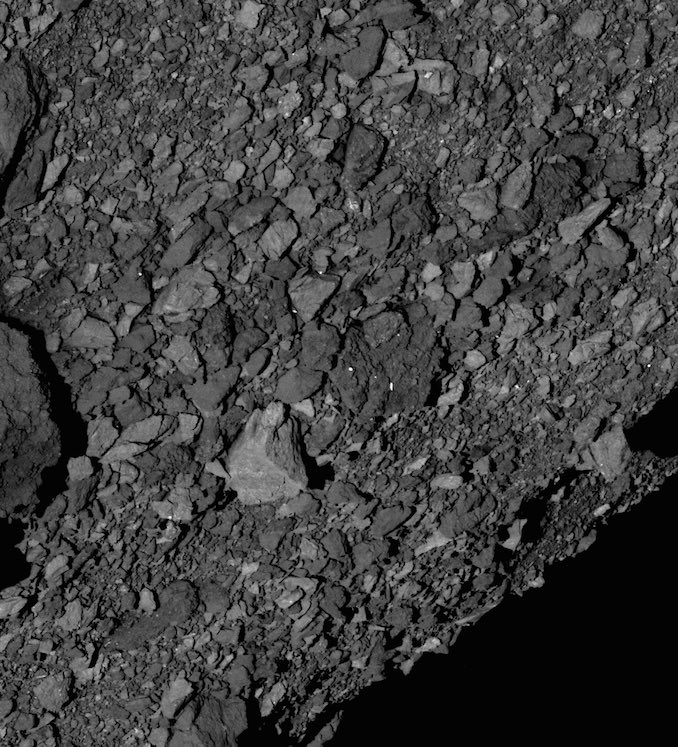
OSIRIS-REx will collect a sample from Bennu’s surface using a device known as the TAGSAM, or the Touch and Go Sample Acquisition Mechanism. Shaped like a car’s air filter, the TAGSAM is mounted on the end of a robotic arm, which will briefly contact the asteroid’s surface, release a bottle of compressed nitrogen gas to scour up bits of dust and rock, then climb away from Bennu a few seconds later.
The TAGSAM nozzle will trap samples blown away by the pulse of nitrogen and suck them into a collector with a rush of air, similar to the way a vacuum cleaner works. Once scientists are satisfied they have a good sample, the TAGSAM head will be placed inside OSIRIS-REx’s return canister for the trip back to Earth.
Engineers originally designed the OSIRIS-REx spacecraft, built by Lockheed Martin, to target a sample collection zone around 164 feet (50 meters) in diameter.
“The asteroid is so rugged there is unlikely to be any 25-meter-radius hazard-free zones,” said Rich Burns, OSIRIS-REx’s project manager at NASA’s Goddard Space Flight Center in Maryland. “What do I mean by hazards? Those big boulders represent hazards, as do severe tilts on the surface, and slopes on the surface of the asteroid.”
Instead, OSIRIS-REx will have to make its descent to Bennu with much greater precision to hit a smaller bullseye.
“You can imagine you’re shooting a dart at a dart board just trying to hit the board, now we’re going to try to hit the center of the bullseye,” Burns said.
The sample collection maneuver is scheduled for mid-2020, and landing of the sample return capsule in Utah planned in September 2023.
Scientists want a relatively smooth location with fine-grained gravel and dust to set OSIRIS-REx down for the sample collection maneuver. When OSIRIS-REx was designed, officials expected Bennu to have broader swaths of suitable sampling regions than it does.
Some impact craters on Bennu appear to contain reservoirs of relatively smooth terrain and fine-grained material. Those sites may be the best options for OSIRIS-REx to capture a sample, scientists said in presentations at the 50th Lunar and Planetary Science Conference near Houston this week.
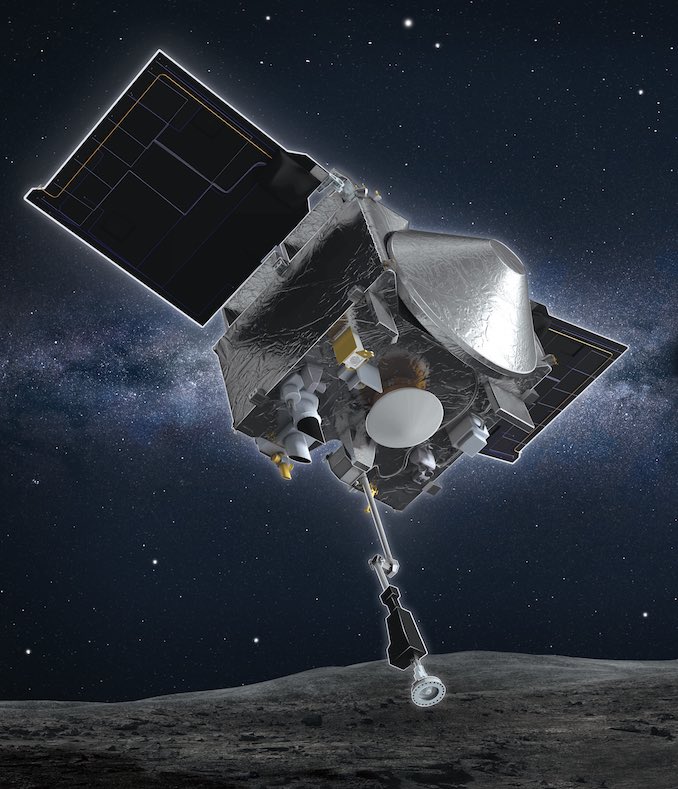
Japan’s Hayabusa 2 mission, which is exploring another asteroid named Ryugu, faced a similar challenge after it arrived at its target last year. Japanese managers found Ryugu was also covered in coarse, rocky material, forcing officials to delay Hayabusa 2’s first touch-and-go landing from last year until February.
Hayabusa 2’s engineers devised a way to get the spacecraft to Ryugu’s surface under tighter constraints the originally planned, aiming for a smaller sampling location wedged between surrounding boulders. The spacecraft successfully gathered a sample from Ryugu on Feb. 21, and is set to return to Earth at the end of 2020.
Lauretta said a contingent of OSIRIS-REx’s team will travel to Japan next month to learn from Hayabusa 2’s experience.
“We feel confident that our systems and our teams are up to the task of tagging to a sample collection site of much smaller area than was previously envisioned,” Burns said.
Email the author.
Follow Stephen Clark on Twitter: @StephenClark1.



